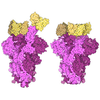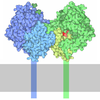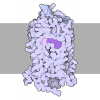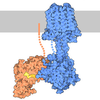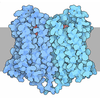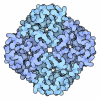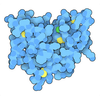+ Open data
Open data
- Basic information
Basic information
| Entry | Database: PDB / ID: 9d0a | ||||||||||||||||||||||||
|---|---|---|---|---|---|---|---|---|---|---|---|---|---|---|---|---|---|---|---|---|---|---|---|---|---|
| Title | CryoEM structure of PAR2 with endogenous tethered ligand. | ||||||||||||||||||||||||
 Components Components |
| ||||||||||||||||||||||||
 Keywords Keywords | IMMUNE SYSTEM / PAR2 / endogenous ligand | ||||||||||||||||||||||||
| Function / homology |  Function and homology information Function and homology informationpositive regulation of neutrophil mediated killing of gram-negative bacterium / : / positive regulation of renin secretion into blood stream / positive regulation of eosinophil degranulation / mature conventional dendritic cell differentiation / leukocyte proliferation / positive regulation of glomerular filtration / regulation of chemokine (C-X-C motif) ligand 2 production / negative regulation of toll-like receptor 3 signaling pathway / positive regulation of toll-like receptor 3 signaling pathway ...positive regulation of neutrophil mediated killing of gram-negative bacterium / : / positive regulation of renin secretion into blood stream / positive regulation of eosinophil degranulation / mature conventional dendritic cell differentiation / leukocyte proliferation / positive regulation of glomerular filtration / regulation of chemokine (C-X-C motif) ligand 2 production / negative regulation of toll-like receptor 3 signaling pathway / positive regulation of toll-like receptor 3 signaling pathway / thrombin-activated receptor activity / positive regulation of actin filament depolymerization / positive regulation of toll-like receptor 2 signaling pathway / cell-cell junction maintenance / Fatty Acids bound to GPR40 (FFAR1) regulate insulin secretion / Acetylcholine regulates insulin secretion / phospholipase C-activating G protein-coupled glutamate receptor signaling pathway / positive regulation of toll-like receptor 4 signaling pathway / positive regulation of pseudopodium assembly / T cell activation involved in immune response / PLC beta mediated events / phospholipase C-activating serotonin receptor signaling pathway / positive regulation of cytokine production involved in immune response / entrainment of circadian clock / regulation of platelet activation / positive regulation of phagocytosis, engulfment / negative regulation of chemokine production / positive regulation of chemotaxis / neutrophil activation / positive regulation of leukocyte chemotaxis / establishment of endothelial barrier / regulation of JNK cascade / regulation of canonical NF-kappaB signal transduction / positive regulation of positive chemotaxis / regulation of canonical Wnt signaling pathway / negative regulation of JNK cascade / glutamate receptor signaling pathway / leukocyte migration / positive regulation of Rho protein signal transduction / regulation of blood coagulation / pseudopodium / positive regulation of interleukin-10 production / PKA activation in glucagon signalling / phototransduction, visible light / developmental growth / hair follicle placode formation / photoreceptor outer segment / negative regulation of tumor necrosis factor-mediated signaling pathway / postsynaptic cytosol / neuropeptide signaling pathway / G-protein alpha-subunit binding / D1 dopamine receptor binding / intracellular transport / vascular endothelial cell response to laminar fluid shear stress / renal water homeostasis / Hedgehog 'off' state / activation of adenylate cyclase activity / adenylate cyclase-activating adrenergic receptor signaling pathway / positive regulation of chemokine production / negative regulation of protein kinase activity / response to prostaglandin E / enzyme regulator activity / positive regulation of GTPase activity / regulation of insulin secretion / cellular response to glucagon stimulus / GTPase activator activity / adenylate cyclase activator activity / Peptide ligand-binding receptors / positive regulation of superoxide anion generation / Turbulent (oscillatory, disturbed) flow shear stress activates signaling by PIEZO1 and integrins in endothelial cells / positive regulation of interleukin-1 beta production / trans-Golgi network membrane / positive regulation of interleukin-8 production / positive regulation of JNK cascade / negative regulation of inflammatory response to antigenic stimulus / G protein-coupled receptor binding / negative regulation of insulin secretion / G protein-coupled receptor activity / bone development / positive regulation of interleukin-6 production / G-protein beta/gamma-subunit complex binding / platelet aggregation / Olfactory Signaling Pathway / Activation of the phototransduction cascade / cognition / G beta:gamma signalling through PLC beta / Presynaptic function of Kainate receptors / Thromboxane signalling through TP receptor / G protein-coupled acetylcholine receptor signaling pathway / positive regulation of type II interferon production / G-protein activation / Activation of G protein gated Potassium channels / Inhibition of voltage gated Ca2+ channels via Gbeta/gamma subunits / adenylate cyclase-activating G protein-coupled receptor signaling pathway / Prostacyclin signalling through prostacyclin receptor / G beta:gamma signalling through CDC42 / Glucagon signaling in metabolic regulation / G beta:gamma signalling through BTK / Synthesis, secretion, and inactivation of Glucagon-like Peptide-1 (GLP-1) / ADP signalling through P2Y purinoceptor 12 Similarity search - Function | ||||||||||||||||||||||||
| Biological species |  Homo sapiens (human) Homo sapiens (human)unidentified (others) | ||||||||||||||||||||||||
| Method | ELECTRON MICROSCOPY / single particle reconstruction / cryo EM / Resolution: 3.1 Å | ||||||||||||||||||||||||
 Authors Authors | Lyu, Z. / Lyu, X. / McGrath, A.P. / Kang, Y. | ||||||||||||||||||||||||
| Funding support | 1items
| ||||||||||||||||||||||||
 Citation Citation |  Journal: Nat Commun / Year: 2025 Journal: Nat Commun / Year: 2025Title: Structural basis for the activation of proteinase-activated receptors PAR1 and PAR2. Authors: Zongyang Lyu / Xiaoxuan Lyu / Andrey G Malyutin / Guliang Xia / Daniel Carney / Vinicius M Alves / Matthew Falk / Nidhi Arora / Hua Zou / Aaron P McGrath / Yanyong Kang /  Abstract: Members of the proteinase-activated receptor (PAR) subfamily of G protein-coupled receptors (GPCRs) play critical roles in processes like hemostasis, thrombosis, development, wound healing, ...Members of the proteinase-activated receptor (PAR) subfamily of G protein-coupled receptors (GPCRs) play critical roles in processes like hemostasis, thrombosis, development, wound healing, inflammation, and cancer progression. Comprising PAR1-PAR4, these receptors are specifically activated by protease cleavage at their extracellular amino terminus, revealing a 'tethered ligand' that self-activates the receptor. This triggers complex intracellular signaling via G proteins and beta-arrestins, linking external protease signals to cellular functions. To date, direct structural visualization of these ligand-receptor complexes has been limited. Here, we present structural snapshots of activated PAR1 and PAR2 bound to their endogenous tethered ligands, revealing a shallow and constricted orthosteric binding pocket. Comparisons with antagonist-bound structures show minimal conformational changes in the TM6 helix and larger movements of TM7 upon activation. These findings reveal a common activation mechanism for PAR1 and PAR2, highlighting critical residues involved in ligand recognition. Additionally, the structure of PAR2 bound to a pathway selective antagonist, GB88, demonstrates how potent orthosteric engagement can be achieved by a small molecule mimicking the endogenous tethered ligand's interactions. | ||||||||||||||||||||||||
| History |
|
- Structure visualization
Structure visualization
| Structure viewer | Molecule:  Molmil Molmil Jmol/JSmol Jmol/JSmol |
|---|
- Downloads & links
Downloads & links
- Download
Download
| PDBx/mmCIF format |  9d0a.cif.gz 9d0a.cif.gz | 229.9 KB | Display |  PDBx/mmCIF format PDBx/mmCIF format |
|---|---|---|---|---|
| PDB format |  pdb9d0a.ent.gz pdb9d0a.ent.gz | 174.8 KB | Display |  PDB format PDB format |
| PDBx/mmJSON format |  9d0a.json.gz 9d0a.json.gz | Tree view |  PDBx/mmJSON format PDBx/mmJSON format | |
| Others |  Other downloads Other downloads |
-Validation report
| Summary document |  9d0a_validation.pdf.gz 9d0a_validation.pdf.gz | 1 MB | Display |  wwPDB validaton report wwPDB validaton report |
|---|---|---|---|---|
| Full document |  9d0a_full_validation.pdf.gz 9d0a_full_validation.pdf.gz | 1 MB | Display | |
| Data in XML |  9d0a_validation.xml.gz 9d0a_validation.xml.gz | 44.4 KB | Display | |
| Data in CIF |  9d0a_validation.cif.gz 9d0a_validation.cif.gz | 66.6 KB | Display | |
| Arichive directory |  https://data.pdbj.org/pub/pdb/validation_reports/d0/9d0a https://data.pdbj.org/pub/pdb/validation_reports/d0/9d0a ftp://data.pdbj.org/pub/pdb/validation_reports/d0/9d0a ftp://data.pdbj.org/pub/pdb/validation_reports/d0/9d0a | HTTPS FTP |
-Related structure data
| Related structure data |  46448MC 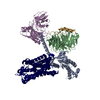 9d4zC 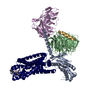 9e7rC M: map data used to model this data C: citing same article ( |
|---|---|
| Similar structure data | Similarity search - Function & homology  F&H Search F&H Search |
- Links
Links
- Assembly
Assembly
| Deposited unit | 
|
|---|---|
| 1 |
|
- Components
Components
| #1: Protein | Mass: 37285.734 Da / Num. of mol.: 1 Source method: isolated from a genetically manipulated source Source: (gene. exp.)  Homo sapiens (human) / Gene: GNB1 / Production host: Homo sapiens (human) / Gene: GNB1 / Production host:  |
|---|---|
| #2: Protein | Mass: 6504.446 Da / Num. of mol.: 1 Source method: isolated from a genetically manipulated source Source: (gene. exp.)  Homo sapiens (human) / Gene: GNG2 / Production host: Homo sapiens (human) / Gene: GNG2 / Production host:  |
| #3: Antibody | Mass: 26679.721 Da / Num. of mol.: 1 Source method: isolated from a genetically manipulated source Source: (gene. exp.) unidentified (others) / Production host:  |
| #4: Protein | Mass: 44173.203 Da / Num. of mol.: 1 Source method: isolated from a genetically manipulated source Source: (gene. exp.)  Homo sapiens (human) / Gene: F2RL1, GPR11, PAR2 / Production host: Homo sapiens (human) / Gene: F2RL1, GPR11, PAR2 / Production host:  |
| #5: Protein | Mass: 41972.578 Da / Num. of mol.: 1 Source method: isolated from a genetically manipulated source Source: (gene. exp.)  Homo sapiens (human) / Gene: GNAQ, GAQ, GNAS, GNAS1, GSP / Production host: Homo sapiens (human) / Gene: GNAQ, GAQ, GNAS, GNAS1, GSP / Production host:  |
| Has ligand of interest | N |
| Has protein modification | Y |
-Experimental details
-Experiment
| Experiment | Method: ELECTRON MICROSCOPY |
|---|---|
| EM experiment | Aggregation state: PARTICLE / 3D reconstruction method: single particle reconstruction |
- Sample preparation
Sample preparation
| Component | Name: Complex of PAR2 with G proteins / Type: COMPLEX / Entity ID: all / Source: MULTIPLE SOURCES |
|---|---|
| Molecular weight | Experimental value: NO |
| Source (natural) | Organism:  Homo sapiens (human) Homo sapiens (human) |
| Source (recombinant) | Organism:  |
| Buffer solution | pH: 7 |
| Specimen | Embedding applied: NO / Shadowing applied: NO / Staining applied: NO / Vitrification applied: YES |
| Specimen support | Grid material: GOLD / Grid mesh size: 300 divisions/in. / Grid type: Quantifoil |
| Vitrification | Cryogen name: ETHANE |
- Electron microscopy imaging
Electron microscopy imaging
| Microscopy | Model: TFS GLACIOS |
|---|---|
| Electron gun | Electron source:  FIELD EMISSION GUN / Accelerating voltage: 200 kV / Illumination mode: FLOOD BEAM FIELD EMISSION GUN / Accelerating voltage: 200 kV / Illumination mode: FLOOD BEAM |
| Electron lens | Mode: BRIGHT FIELD / Nominal defocus max: 2000 nm / Nominal defocus min: 800 nm |
| Image recording | Electron dose: 45 e/Å2 / Film or detector model: TFS FALCON 4i (4k x 4k) |
- Processing
Processing
| EM software | Name: PHENIX / Category: model refinement | ||||||||||||||||||||||||
|---|---|---|---|---|---|---|---|---|---|---|---|---|---|---|---|---|---|---|---|---|---|---|---|---|---|
| CTF correction | Type: PHASE FLIPPING AND AMPLITUDE CORRECTION | ||||||||||||||||||||||||
| 3D reconstruction | Resolution: 3.1 Å / Resolution method: FSC 0.143 CUT-OFF / Num. of particles: 404635 / Symmetry type: POINT | ||||||||||||||||||||||||
| Refinement | Highest resolution: 3.1 Å Stereochemistry target values: REAL-SPACE (WEIGHTED MAP SUM AT ATOM CENTERS) | ||||||||||||||||||||||||
| Refine LS restraints |
|
 Movie
Movie Controller
Controller





 PDBj
PDBj
